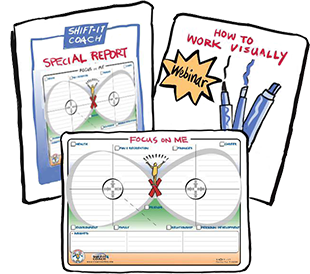We recently had a new moon, a new year and a new decade … the perfect time to make a clear and committed intention for what you want next.
In this energy I launched one of my online SHIFT-IT Groups … with 30+ participants from around the globe (North America, U.K., Belgium, Italy, and a first … Kenya!).
Many in this group are already consultants, coaches and other types of helping and creative professionals and/or small business owners – and some, are in that exciting, confusing and sometimes scary process of creating that kind of independent lifestyle.

And, as I’ve also got my BFF (best friend forever) Julie visiting me this weekend from San Francisco (she just left her corporate job as an organizational development manager for a U.S. health care company and wants to create an internet based lifestyle next) I’m jotting down some quick tips for those of you making this same kind of SHIFT.
1. Don’t Do Anything Rash
Different people have different levels of tolerance for risk and ambiguity and, varying levels of emotional and financial support. If you have a high tolerance for risk and a supportive situation, then by all means … take a running leap and just go for it! However, if you (like most of us) don’t exactly thrive on adrenaline and your support isn’t 100% iron clad, then it behooves you to slow down and plot your plan.
2. Educate Yourself
Before resigning, Julie spent several years contemplating her SHIFT and educating herself about her options. She talked to consultants (in her previous position she often hired them to do projects within the organization), she attended networking groups for entrepreneurs and small business owners, and she read books, bought educational products and attended different kinds of learning experiences (mine and lots of others).
3. Make Preliminary Changes
A year before she completely quit, Julie had a huddle with her boss and explained her need to make some changes. She applied for several shorter-term assignments within the organization and landed one that required her to commute to another state (thankfully it was Hawaii so it had some perks!). This opportunity allowed her to step away from her usual day-to-day but also keep a stable income coming in. And, it bought her a little downtime on the weekends she didn’t commute back home to see her boyfriend – downtime that she used to ponder and research her shift (even when we don’t think we are doing anything our subconscious mind is working away on our dilemma).
4. Buy Yourself Some Time
When you are making the SHIFT from employee to self-employment or small business creation – time (and your energy) become the key. Most employees nowadays have very full lives, and like Julie, sometimes work way beyond the so-called normal workweek of 40 hours. In order to break this cycle, you need to figure out how to create more time for yourself (and the development of your venture) … by either keeping your present job (and implementing boundaries) or by leaving it.
Implementing boundaries means leaving your work at an agreed upon time and sticking to it (like 5 or 6pm … and being sure to take the breaks coming to you (including all your vacation days) – even if others in your corporate culture frown upon this). Or, even better, negotiating less work hours (like going to a 3 or 4 day work week or an abbreviated day — many employers are particularly open to this during a down economy). Or working more from home (to reclaim some of those wasted commute hours). In the time that is saved, you also must be disciplined to use it to create and execute your business development plan for your new venture.
5. Enlist Those Closest to You
Once you have created a draft of a basic life/business plan (see my SHIFT-IT Home Retreat Kit as a good resource to do this), its now time to discuss your desired shift with those closest to you and to enlist their support and help (emotionally and/or financially). Chances are if you are partnered, you and your significant other have already discussed this to some extent. Now is the time to show them your more advanced thinking and to involve them in your vision and action plan.
Ideally, your partner will support your decision and together you plot your course (thankfully Julie’s boyfriend Michael is thrilled she has finally left the corporate world … as he’s been self-employed for years and was worried about her long-term health with the load she was carrying).
It’s not unusual for couples to do dual plans. One person makes their shift and gets themselves stabilized and then they support the other partner to make his or her shift – really displaying partnership and resourcefulness to work together to keep each person satisfied and fulfilled in work and life.
Unfortunately, not all partnerships are so supportive. Some people encounter resistance and even hostility when engaging their partners with their shift plans. Sometimes this resistance softens over time, as the resisting partner sees their partner walking their talk and doing what they said they would – they literally win them over step-by-step (by creating a legitimate, ultimately income producing practice or business). Other times, the resisting partner never changes their tune. And, the shifting partner is faced with making decisions about their relationship – stay, go or somewhere in-between.
If you are single or do not have significant others in your life there are different pros and cons. You have the pro of not having to negotiate with another person at that intimate level. But then you also have the cons of not having others to potentially support you during your shift. However, if you are lacking foundational support, you can identify this weakness in your business plan and build it in accordingly (like getting a coach, enlisting in a mastermind group, seeking out local small business development resources, etc).
6. Have Realistic Expectations
Anybody who has created independent work will tell you that it IS possible however it takes considerable time, effort and investment. People new to it can often underestimate the amounts of all three that are required (especially if they have listened to the more unscrupulous of the teachers and so-called guides out there). Your shift to self-employment or small business will take time and a lot of effort …even, or especially, if it is primarily internet based. As you are learning and putting your products and/or services and related systems in place, you will need to figure out how to support yourself in the interim (if you aren’t independently wealthy or have someone to financially assist you) … and/or get comfortable with accumulating some necessary, strategic debt that you will eventually have to repay (all part of that good, informed business plan).
7. Accept Your Timing
When you make your shift, do me a favor and don’t knock yourself for how long it takes. You are a unique individual with your own unique set of circumstances. DO NOT succumb to your temptation to compare yourself to others, especially if you don’t have access to the true inside scoop of their tale. Also, do not criticize yourself for being more cautious or apprehensive given the economic course correction that our global economy is navigating its way through – your pace is most likely the very best thing to do, for you. You will make your shift in your own perfect timing. When you do, I look forward to hearing about it!
Blog Comments: Thoughts? Reactions? Have something to add? Click here
to leave comments and read those left by others.
Audio MP3s of Past Articles: Click Here




What a great article Christina! It’s great to see someone encouraging a rational thoughtful approach to the shift to self-employment. I’ve been seeing a lot of what I regard as irresponsible recommendations from people that if you aren’t “investing” enough money, you aren’t playing “big enough.” (Leading to the “big enough according to whom” question in my mind!) I even wrote a bit of rant about that in my newsletter last week. We all have our own tolerance for financial and emotional risk, as you point out.
Anyway, I made the shift to self-employment 15 years ago, but I still remember how huge and scary it felt that first day when I suddenly had no “job” to go to! Thank you for putting this nurturing supportive advice out there.
– Susan
Thank you for including # 7 in this post. I was laid off from corporate America, had health issues, then a bad accident so couldn’t work, financial problems from all of that, etc. I finally made up my mind to change my life and spent the time and work necessary to do it.
Everything is coming together now. My life is much more fulfilling. I am excited to be starting my online/offline business this year. Now that I am actually ready inside, resources and supportive people are popping up everywhere!
When you said “your pace is most likely the very best thing to do for you” and “you will make the shift in your own perfect timing” I laughed aloud with the joy of relating to those statements and knowing that I have made that necessary shift. One of my affirmations this past week, created before I ever saw this blog post, is: I control my own pace.
It was created on a day that I was feeling too much overwhelm. It calms me down and helps me every single time I say it. A friend of mine told me she is going to make a sign up for me with that saying on it to hang in my office.
I love the serendipity in life. Blessings to all who read this.